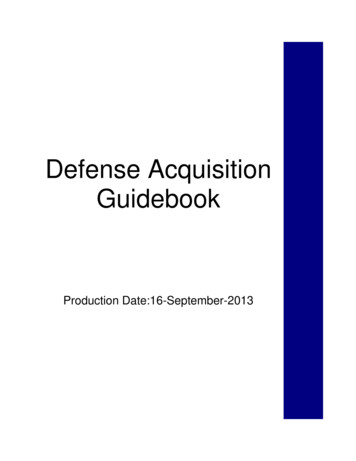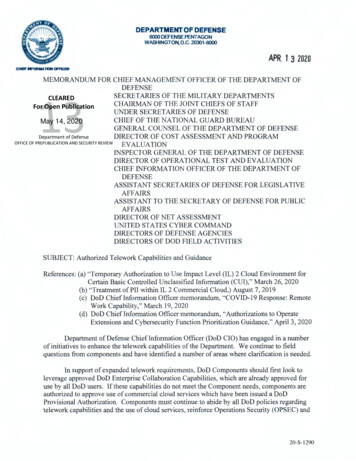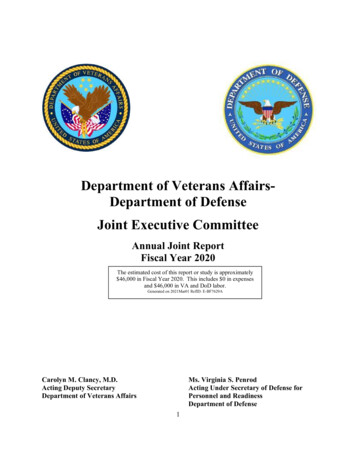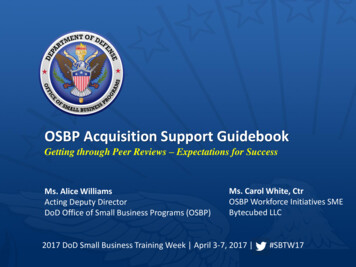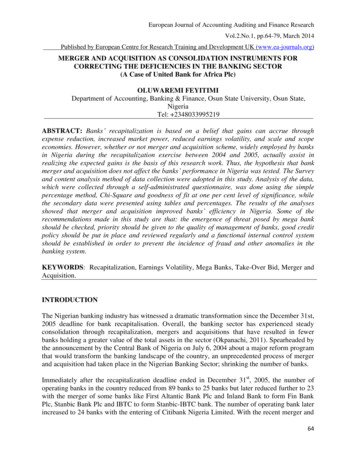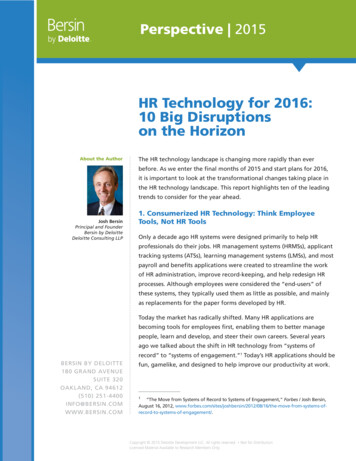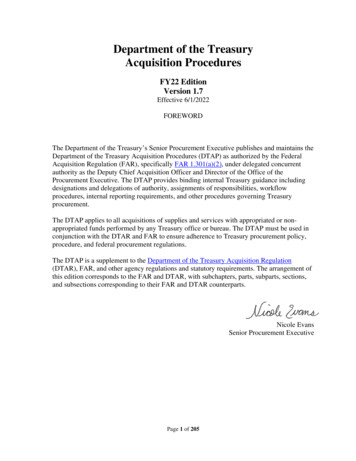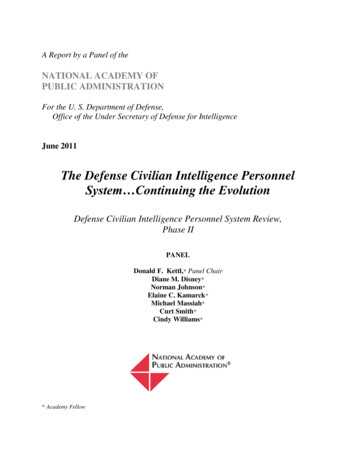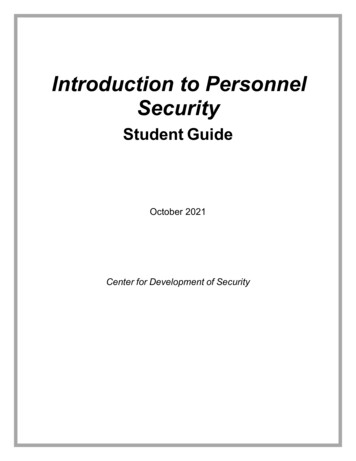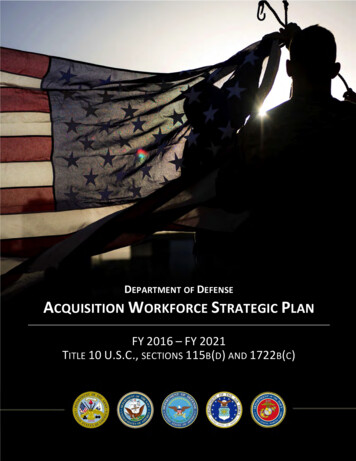
Transcription
DEPARTMENT OF DEFENSEACQUISITION WORKFORCE STRATEGIC PLANFY 2016 – FY 2021TITLE 10 U.S.C., SECTIONS 115B(D) AND 1722B(C)i
"In the end, it is the quality of our people that matters the most,more so than any policy or regulation anyone can put in place"— Mr. Frank KendallUnder Secretary of Defensefor Acquisition, Technology, and Logistics (USD(AT&L))iDoD Acquisition Workforce Strategic Plan — FY 2016 – FY 2021
A Message from theUnder Secretary ofDefense for Acquisition,Technology, and LogisticsWe have made unprecedented progress in rebuilding andprofessionalizing our workforce—the key to improving the way we dobusiness. By harnessing an increasingly professional acquisitionworkforce guided by the tenets for our Better Buying Power (BBP)initiatives, we have substantially improved the efficiency andproductivity of acquisition programs. For example, analysis shows thatwe are achieving the best results at controlling costs on major acquisition programs at any time in thelast 35 years. With the latest version of the Department of Defense (DoD) Instruction 5000.02,“Operation of the Defense Acquisition System,” we established a revised framework that is better suitedto shaping acquisition processes and requirements for programmatic needs. It is designed to empowerthe acquisition workforce to make the right decisions to buy the right systems to support the Warfighterat the right time. This is particularly important in light of the increasingly technical complexity of thedesigns of many warfighting systems, the rapid cycle of technological innovation, and the multiplicity ofthe threats we face. A highly skilled and professional acquisition workforce is essential to improving theflexibility of the acquisition framework and getting warfighting systems into the hands of our Servicemembers.The Department’s efforts to strengthen workforce capabilities and promote professionalism of theacquisition workforce have covered a wide range of initiatives, addressing recruiting, workforcedevelopment, and talent management challenges. The Department has made progress in rebalancingand increasing the workforce to meet our workflow, and it is further reshaping disciplines related toemergent threats and challenges such as cybersecurity and information technology. We continue tofocus our recruiting and retention programs on identifying, hiring, and retaining the best and thebrightest in the disciplines vital to meeting today’s challenges while anticipating those of the future. TheDepartment has also initiated an effort to ensure that acquisition leaders across the enterprise are fullyqualified, experienced, and capable of performing all aspects of their assignments. We haveemphasized the importance of having a pool of talent ready to assume positions at all levels. Byimproving our training and certification programs for acquisition professionals, we ensure workforcemembers have the skills and knowledge necessary to effectively do their jobs. We have also institutedmore comprehensive awards programs in order to recognize excellence and to incentivize highachievement and performance. Finally, we are expanding the Civilian Acquisition Workforce PersonnelDemonstration Project so that more organizations can take advantage of the hiring flexibilities andcontribution-based incentives it offers.On behalf of approximately 156,000 acquisition professionals across the Department, I want to extendmy appreciation to the members of Congress for their ongoing support of acquisition workforceexcellence and specifically for the permanency of the Defense Acquisition Workforce Development Fund(DAWDF), the Expedited Hiring Authority, and the extension of the Civilian Acquisition WorkforceiDoD Acquisition Workforce Strategic Plan — FY 2016 – FY 2021
Personnel Demonstration Project (AcqDemo). I would also like to thank the Services and DefenseAgencies, the Defense Acquisition University, and associated offices throughout the Department fortheir leadership in driving acquisition excellence through continuous workforce improvement.The Department must responsibly sustain the acquisition workforce size modulated by workloaddemand and requirements; ensure its personnel continue to increase their professionalism by helpingthem obtain training, education, and experience they need to be effective; and continue to expandtalent management programs to include recruitment, hiring, training, development, recognition andretention initiatives by using the DAWDF and other appropriate tools.Our goal is to build on the progress achieved to date. This strategic plan sets forth overarching guidancefor the next five years. It emphasizes constant improvement of our acquisition workforce to ensure theUnited States continues to field the best-equipped military in the world. I am confident our dedicatedand professional workforce will rise to this challenge, and I will do everything in my power to help it doso.Frank KendalliiDoD Acquisition Workforce Strategic Plan — FY 2016 – FY 2021
Table of ContentsA Message from the Under Secretary of Defense for Acquisition, Technology, and Logistics . iTable of Contents . iiiMission and Vision .1Our Mission . 1Our Vision . 1Our Ethos. 1Introduction .2Scope . 2FY 2016 – FY 2021 Strategic Goals . 3Structure of the Acquisition Workforce Strategic Plan . 3Section 1: Background .4Defense Acquisition Workforce Development Fund – A Significant Enabler. 5Accomplishments of the FY 2010 – FY 2015 Strategy . 5Current Environment and Challenges . 6Section 2: Management Framework .8Statutory Authority, Roles, and Responsibilities . 8Joint Governance Forums . 10Competency Framework . 10Competency Management. 10Talent Management . 11Comprehensive Framework Positions DoD for Success. 11Section 3: State of the Workforce . 12Acquisition Workforce Size and Shape . 12Certification. 16Education . 17Training . 18Experience . 19Leadership Development. 19Challenge – Responsibly Sustain and Continue . 20iiiDoD Acquisition Workforce Strategic Plan — FY 2016 – FY 2021
Section 4: Looking Ahead . 21Goal 1: Make the Department of Defense an employer of choice . 22Improve Recruitment policies and practices across the Department of Defense to establish andcommunicate a distinctive DoD AWF Brand. . 22Increase hiring flexibilities and reduce barriers to hiring . 22Offer competitive compensation and incentives. 23Improve work-life balance . 23Goal 2: Shape the Acquisition Workforce to achieve current and future acquisition requirements . 24Continuously monitor the health and capability to ensure a balanced acquisition workforce . 24Ensure our acquisition workforce has skillsets to achieve technical excellence . 24Succession planning is a priority . 25Goal 3: Improve the quality and professionalism of the Acquisition Workforce . 26Career Development . 26Training . 26Education . 27Experience . 28Goal 4: Continuously Improve Workforce policies, programs, and processes . 29Improve the processes for education, training, experience, and career development programs . 29Improve analytics for acquisition workforce planning and decisions . 29Establish consistent management and utilization of DAWDF funding across the Department . 30Establish AcqDemo as the Personnel Management System for the DoD AWF . 31Summary . 32Appendix 1 – Department of the Army . 33Appendix 2 – Department of the Navy . 39Appendix 3 – Department of the Air Force . 43Appendix 4 – 4th Estate. 49Appendix 5 – Defense Acquisition University . 53Appendix 6 – Defense Contract Management Agency. 59Appendix 7 – Defense Logistics Agency . 62Appendix 8 – Auditing . 66Appendix 9 – Business . 71ivDoD Acquisition Workforce Strategic Plan — FY 2016 – FY 2021
Appendix 10 – Contracting . 75Appendix 11 – Engineering . 81Appendix 12 – Facilities Engineering . 87Appendix 13 – Information Technology . 92Appendix 14 – International Acquisition . 100Appendix 15 – Life Cycle Logistics . 102Appendix 16 – Production, Quality and Manufacturing . 108Appendix 17 – Program Management . 115Appendix 18 – Science and Technology Manager . 122Appendix 19 – Small Business . 126Appendix 20 – Test and Evaluation . 131Appendix 21 - Additional Information on the Defense Acquisition Workforce . 137“HCl's mission is to execute Department of Defense(DoD)-wide acquisition workforce governance,strategies, policies, programs, and talentmanagement initiatives to equip a highly-qualifiedRene' Thomas-RizzoDirector, Human CapitalInitiatives,Office of the UnderSecretary of Defensefor Acquisition,Technology and Logisticsworkforce of professionals in acquiring anddelivering world-class warfighting capabilities toour Soldiers, Sailors, Airmen, and Marines.”— HCI Charter 1 Nov 2015vDoD Acquisition Workforce Strategic Plan — FY 2016 – FY 2021
Mission and VisionOur MissionRecruit, hire, develop, and retain a diverse, agile, highly qualified, and motivated workforce ofacquisition professionals to acquire and deliver world-class warfighting capabilities for our Soldiers,Sailors, Airmen, and Marines.Our VisionTo create a high quality, high-performing, agile Defense Acquisition Workforce that is empowered todeliver the best possible acquisition outcomes in support of the Warfighter.Our EthosAcquisition, Technology, and Logistics (AT&L) is in pursuit of developing the most versatile acquisitionworkforce that routinely operates on the following ethos: Invest in your people Uphold ethics at any price Choose the right person, rightskills, right job, right time Demand accountability Make sound business decisionsSupport the Warfighter Critical thinking is essentialProtect the taxpayer Foster diversityEnsure leadership is doing theright things Maintain technical superiorityDefense Acquisition is a team sport, and mission success is only as good as the products and services weacquire on behalf of the Warfighter.“(T)he most important factor in the performance of the Defense Acquisition System:the capability of the professionals in our acquisition workforce, which includesprogram management, engineering contracting, and product support disciplinesengaged in a wide range of active ties throughout the product lifecycle”— BBP 2.0 Guidance and Actions April 20131DoD Acquisition Workforce Strategic Plan — FY 2016 – FY 2021
IntroductionScopeThis plan covers the 156,000 military and civilian acquisition workforce (AWF) professionals across theDepartment, to include the military departments and defense agencies. The AWF includes 15 functionalcommunities, each contributing to the mission of acquiring and delivering world-class warfightingcapabilities to our Soldiers, Sailors, Airmen, and Marines.The plan outlines goals and objectives to sustain and improve the capacity and capabilities of theDepartment of Defense (DoD) AWF. The goals are aligned and support overarching DoD strategicdirection, including Better Buying Power (BBP) objectives, to improve the professionalism of the totalAWF. The plan meets the strategic planning requirements of sections 115b and 1722b of title 10, UnitedStates Code (U.S.C.). It is a report on our progress and provides overarching guidance for the comingyears.Congress and DoD have long recognized the importance of the AWF to achieving the timely and costeffective development and delivery of warfighting capabilities to America’s combat forces. DoD’sacquisition mission represents the largest buying enterprise in the world—the AWF is responsible forinvesting over 1 trillion in taxpayer dollars to equip and sustain the Warfighter through fiscal year (FY)2021. Today, we have achieved many of the goals set in the FY 2010 – 2015 strategic plan which werespecific to growing the AWF by 20%. The goals established in this FY 2016 – 2021 plan are enduring and,with the DAWDF, DoD is positioned to continue strengthening and responsibly sustaining the AWF.2DoD Acquisition Workforce Strategic Plan — FY 2016 – FY 2021
FY 2016 – FY 2021 Strategic GoalsThe Department must ensure it has an acquisition workforce capable of delivering technologicalsuperiority to the Warfighters. The challenges we face today require us to pursue the following goals,which were developed in partnership with Component acquisition and Functional community leadersand approved by the Defense Acquisition Workforce Senior Steering Board (SSB).Goal 1:Make the Department of Defense an employer of choiceGoal 2:Shape the Acquisition Workforce to achievecurrent and future acquisition requirementsGoal 3:Improve the quality and professionalism of the Acquisition WorkforceGoal 4:Continuously improve Workforce policies, programs, and processesStructure of the Acquisition Workforce Strategic PlanThe main body of the plan consists of four sections: Background. Provides an overview of the strategy and accomplishments in the FY 2010plan, the role of DAWDF, and the current environment and challenges. Management Framework. The governance structure responsible for AWFmanagement, manpower resource management, and alignment of this plan tostatutory and regulatory requirements. State of the Workforce. Assessment of factors indicative of the current capacity andcapability of the workforce and of risks the Department must manage in order tosustain and develop the capacity and capabilities required in the future. Looking Ahead. Strategic goals and supporting initiatives.In addition, the appendices provide details for each of the Services, the major Defense Agencies, andeach acquisition functional area.3DoD Acquisition Workforce Strategic Plan — FY 2016 – FY 2021
Section 1: BackgroundThe 2010 DoD Strategic Human Capital Plan Update acknowledged that, due to efforts to reduceGovernment and outsource tasks to civilian contractors, the Defense AWF decreased substantially (56percent) between 1987 and 2004. This trend continued, despite an increasing acquisition workload,until 2009, when it became apparent the DoD AWF lacked the capacity and capability to meet growingdemands. The Executive Branch and members of Congress consequently recognized the need to restoreDoD’s acquisition workforce. DoD’s ability to restore the workforce was enabled by five major factors:A foundation of statutory authorities, management strategy based on alignment and decentralizedexecution, well-established management functions, joint governance, and a statutory-based workforcefund. Each of these factors is covered in greater detail below.In March 20091, the President released a memorandum directing the Office of Management and Budget(OMB) to assist agencies in assessing the capacity and ability of their AWF’s to develop, manage, andoversee acquisitions. Additionally, in April 2009, the Secretary of Defense (SECDEF) issued theDepartment’s key objectives, which included a call for a fundamental overhaul of the DoD acquisitionsystem and a challenge to restore the size and improve the quality and readiness of the AWF. The 20102Quadrennial Defense Review (QDR) cited acquisition reform, including AWF rebalancing, as afundamental and vital part of the Nation’s Defense Strategy, pledging to increase the size of the AWF by20,000 positions by 2015 and promising to “enhance training and retention programs to bolster thecapability and the size of the acquisition workforce.” (QDR 2010)“However, if there is one thing that has impressed me during my 40-plus years indefense acquisition, most of it in government, it is the dedication, positive attitude,resilience and desire to serve the taxpayer and our Servicemen and -women wellthat characterizes this country’s acquisition professionals . This country owes alot to you; together with our industry partners, you are the reason we have the bestequipped military in the world.”— Frank Kendall USD(AT&L)President Obama’s Memorandum for the Heads of Executive Departments and Agencies – Subject: GovernmentContracting, dated March 4, 20092Quadrennial Defense Review, February 2010, page viii14DoD Acquisition Workforce Strategic Plan — FY 2016 – FY 2021
The 2010 DoD Strategic Human Capital Plan stated that DoD “will place a greater emphasis on a highquality workforce having the right competencies and skill sets, at the right places, at the right time.” Theplan included the following objectives:ObjectiveStrategic Sizingand Shaping of AWFImproveWorkforceQualityRetentionand RecognitionInitiatives Increasing AWF size by 20,000 (half new hires/half insourced positions) by 2015 Strategic reshaping of acquisition career fields bydeliberate and targeted growth of specific career fields Reinventing Defense Acquisition WorkforceImprovement Act (DAWIA) certification structure with agreater emphasis on experience and fully qualifiedemployees Ensuring a qualified organic workforce Investing in leadership development Meeting the growing demand for acquisition training Assessing workforce competencies Retention and other related AWF initiatives Recognizing AWF excellenceTable 1-1 DoD Strategic Human Capital Plan UpdateThe Defense Acquisition Workforce Objectives and Initiatives, April 2010Defense Acquisition WorkforceDevelopment Fund – A Significant EnablerIn order to restore, responsibly sustain, and continuously improve the quality of the AWF, sufficient andstable dedicated funding is required. Congress established the DAWDF in 2008 to ensure DoD has “thecapacity, in both personnel and skills, needed to perform its acquisition mission, provide appropriateoversight of contractor performance, and ensure the Department receives best value for expenditure ofpublic resources.”3 The DAWDF supports efforts to meet the Department’s workforce challenges andrestore the organic defense AWF by funding initiatives in three major categories: recruitment andhiring, training and career broadening, and recognition and retention. Congress has continued tosupport DoD’s efforts to strengthen and improve the quality of the AWF. Since 2010, there have beenseveral adjustments to the DAWDF, most significantly DAWDF permanency in the FY 2016 NationalDefense Authorization Act.Accomplishments of the FY 2010 – FY 2015 StrategyAs previously stated, the AWF was downsized by 56 percent prior to 2010 in order to reduce theGovernment footprint. The Department fell below acceptable staffing levels, and the focus in the pastwas simply ensuring we had the numbers to accomplish the mission and the ability to overcome3Title 10, U.S.C., section 1705, Defense Acquisition Workforce Development Fund5DoD Acquisition Workforce Strategic Plan — FY 2016 – FY 2021
attrition challenges. The Department’s 2010 growth strategy addressed the needs to rebuild capacity,improve quality, and rebalance the workforce to ensure effective oversight and inherently governmentalresponsibilities are performed by organic AWF members. Section 3 of the Strategic Plan, “State of theWorkforce,” addresses the Department’s growth strategy and concerns in greater detail.The cumulative efforts of the Components from FY 2009 through FY 2015 increased the acquisitionworkforce size, rebuilding capacity by 24.1 percent from 125,879 to 156,313. Efforts strategicallyshaped the workforce by bolstering critical functions and building early and mid-career workforce size.DoD expanded training and deployed acquisition tools and specialized workshops to support theworkforce on the job, resulting in a more proficient and capable acquisition workforce. The DefenseAcquisition University (DAU) increased training capacity in required certification courses and eliminatedbottlenecks in the training path. Component leadership emphasis and increased training capacity led toimproved certification levels, which increased from 86 percent in FY 2008 to 96 percent in FY 2015. Thenumber of individuals with a bachelor’s degree or higher in the acquisition workforce increased from 77percent in FY 2008 to 84 percent in FY 2015. Additionally, the number of individuals with a graduatedegree increased from 29 percent in FY 2008 to 39 percent in FY 2015. DAWDF-funded effortscontributed to these improvements and support the BBP objective to increase the professionalism ofthe total acquisition workforce.Current Environment and ChallengesThe United States is facing what the Chairman of the Joint Chiefs of Staff describes as “the mostunpredictable” global security environment in over 40 years. We simultaneously face securitychallenges from adversary states and regional networks of sub-state groups. As stated in theImplementation Guidance to BBP 3.0, April 9, 2015:The technological superiority of the United States is nowbeing challenged by potential adversaries in ways not seensince the Cold War. Efficiency and productivity are alwaysimportant, but the military capability that we provide toour Warfighters is paramount. Our operationaleffectiveness is based on the quality of our people and thequality of our products. The former is not in doubt; thelatter depends on our efforts and on those of the industrialbase. We will continue our work to improve productivityand efficiency, but we must also turn our attentionincreasingly to our ability to innovate, achieve technicalexcellence, and field dominant military capabilities.The Warfighter will require the capability to counter a widerange of threats from leading edge cyber-attacks, acts ofterrorism, and sophisticated weapons. Geopolitical andtechnological demands call for maintaining the superiorityand flexibility of the force structure and dictate investment inthe capability needed to pace the threat. It is an absolute6DoD Acquisition Workforce Strategic Plan — FY 2016 – FY 2021
necessity that the United States maintains a technological edge over enemies by fielding dominantwarfighting capability. The AWF is critical to equipping the Warfighter with this capability.“Today’s security environment is dramatically different – and more diverseand complex in the scope of its challenges – than the one we’ve been engagedwith for the last 25 years, and it requires new ways of thinking and new waysof acting.”— Ashton Carter Secretary of Defense March 17, 2016DoD’s ability to responsibly sustain improvements and continue efforts to strengthen the AWF ischallenged by the current fiscal environment. The continuation of fiscal constraints imposed bysequestration, the uncertainty engendered by the annual budget turmoil, and threats of Governmentshutdown could negatively affect warfighting capability and recent workforce improvements. DoD hasbeen granted significant relief from the sequestration cuts in FY 2014 and FY 2015 by the BipartisanBudget Act of 2014 and in FY 2016 and FY 2017 by the Bipartisan Budget Act of 2015. These actionshave provided much needed stability. However, it should be noted that for FY 2018 and beyond,sequestration relief has not been endorsed. In spite of this fiscal environment, DoD’s AWF iswell-postured for the future. Our investment in the workforce since 2009 is paying off.The following sections provide additional information on the management framework, state of theworkforce, looking ahead, and specific component and functional details.7DoD Acquisition Workforce Strategic Plan — FY 2016 – FY 2021
Section 2: Management FrameworkDoD’s comprehensive AWF management framework includes the following elements: statutory–based,centralized DoD-wide policy and standards with decentralized execution by the Compone
DoD Acquisition Workforce Strategic Plan — FY 2016 - FY 2021 A Message from the Under Secretary of Defense for Acquisition, Technology, and Logistics We have made unprecedented progress in rebuilding and professionalizing our workforce—the key to improving the way we do business. By harnessing an increasingly professional acquisition

